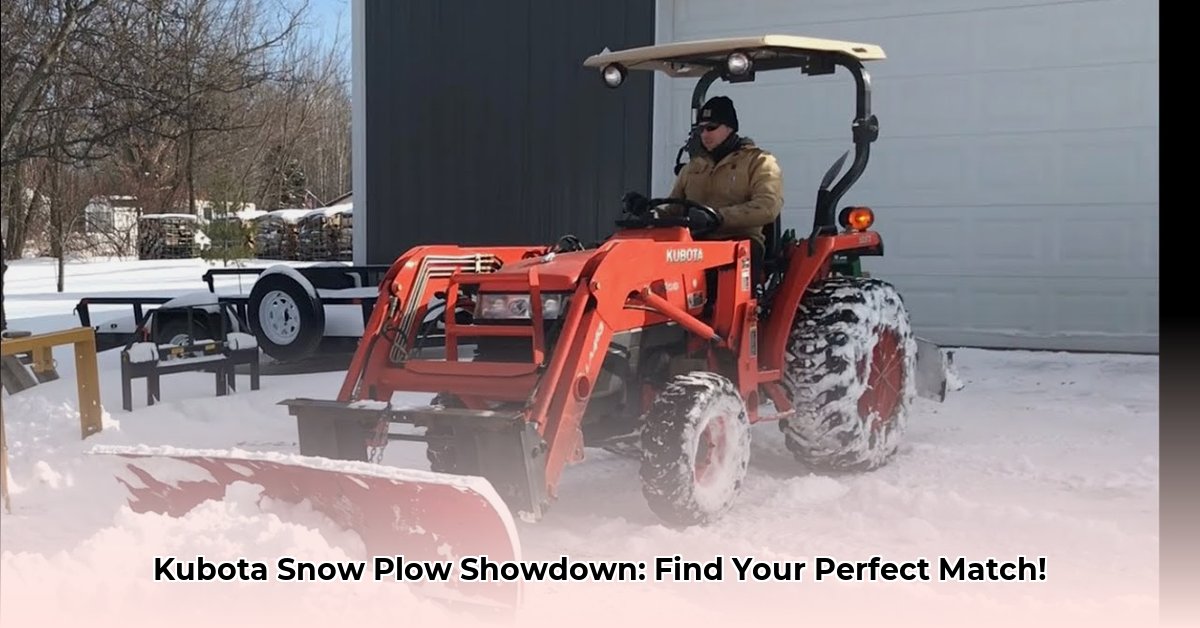
Choosing the Right Snow Plow for Your Kubota Tractor
Facing winter's wrath? Don't let snow pile up! Selecting the right snow plow for your Kubota tractor is crucial for efficient and safe snow removal. This guide will help you navigate the choices, from understanding your needs to maintaining your equipment. We’ll cover mounting systems, blade types, angling options, and essential maintenance, ensuring you’re ready to conquer any winter storm. For additional resources on snow removal equipment, check out this helpful guide: snow removal equipment.
Assessing Your Needs: A Crucial First Step
Before you start browsing snow plows, carefully consider these factors:
Snowfall & Property Size: Do you regularly experience light, fluffy snow or heavy, wet snow? A small driveway requires a different plow than a large field. Consider the average snowfall in your area and the size of the area you need to clear. A larger property necessitates a more robust and potentially wider plow.
Kubota Tractor Capacity: Consult your Kubota's owner's manual to determine its horsepower and lifting capacity. Never exceed these limits; overloading is extremely dangerous and can damage your tractor. A heavier-duty plow will require a more powerful tractor.
Budget Considerations: Snow plows range in price significantly, depending on features, build quality, and materials. Determine a comfortable budget before you start shopping to prevent impulse purchases.
Frequency of Use: Will you use the snow plow only a few times a year, or will you need it frequently during the winter months? This will influence your choice of mounting system.
Mounting Systems: Understanding Your Options
Three primary mounting systems exist for Kubota tractor snow plows:
Clamp-On: These are generally less expensive and easier to install and remove. They are well-suited for occasional use. However, they can be time-consuming to attach and detach, making them less efficient for frequent snow removal.
Quick-Attach: These provide faster attachment and detachment, ideal for frequent use. They usually provide superior ground following compared to clamp-on systems, improving efficiency. However, they typically come with a higher initial cost.
Euro-Hitch: This system is typically used with larger tractors and heavier-duty plows. It offers superior robustness and durability but requires a tractor equipped with a Euro-Hitch.
The best choice depends on your frequency of use and your budget. For occasional use, a clamp-on system might suffice. For more frequent snow removal, a quick-attach system offers greater efficiency.
Blade Selection: Material, Width & Durability
The snow plow blade is the heart of the operation. Key considerations include:
Blade Material: Heavy-duty steel is recommended for heavy, wet snow. Thinner gauge steel might be suitable for lighter snowfalls but offers less durability. Some plows feature replaceable cutting edges, extending their lifespan.
Blade Width: Wider blades clear more snow per pass but might require a more powerful tractor, especially in tight spaces. Consider the size of your driveway and the dimensions of your Kubota.
Construction Quality: A well-built blade will last longer and perform better. Look for reinforced edges and robust construction.
Do you need a wider blade for greater efficiency, or a narrower one for increased maneuverability in tight spaces? The answer depends on your specific needs.
Angling Control: Manual vs. Hydraulic Options
How you control the plow's angle significantly impacts efficiency and ease of use:
Manual Angling: This simple system usually allows for a 30-degree range of adjustment, but it requires you to dismount the tractor to change the angle. It is less expensive but slower.
Hydraulic Angling: Using hydraulics lets you adjust the plow's angle from your tractor seat, offering superior precision and speed, especially for larger areas. While more expensive, hydraulic angling significantly improves efficiency and comfort.
Is the added cost of a hydraulic angling system justified by the increased convenience and speed? This is a key question to consider based on your budget and the scale of your snow removal tasks.
Installation & Maintenance: Ensuring Long-Term Performance
Proper installation and regular maintenance are crucial for maximizing your snow plow's lifespan and ensuring safe operation:
Installing a Quick-Attach Plow: (Note: Consult your plow’s specific instructions for detailed guidance.)
Engage the parking brake, switch off the tractor engine, and ensure the area is clear of obstructions.
Align the quick-attach bracket with your tractor's three-point hitch, ensuring it’s correctly positioned.
Connect the hydraulic lines (if applicable) securely, double-checking all connections.
Insert and lock the safety pins, confirming they are firmly in place.
Test the system, activating the hydraulics and checking the angling mechanism before commencing snow removal.
Maintenance:
- Clean the blade thoroughly after each use, removing ice, snow, and debris.
- Regularly inspect the mounting system, hydraulic lines, and cutting edge for any damage or wear.
- Lubricate moving parts as recommended in your plow's manual.
- Store the plow in a dry, protected location during the off-season.
Compatibility: A Critical Consideration
Before purchasing any snow plow, always verify compatibility with your specific Kubota tractor model. Check the manufacturer's website for compatibility charts or contact customer support. Reading online reviews from other Kubota owners can provide valuable insights. Using incompatible equipment can be unsafe and void warranties.
"Always prioritize safety and consult both your Kubota's and the snow plow's owner's manuals before operation," advises Dr. Emily Carter, Agricultural Engineering Professor at Purdue University.
This comprehensive guide aims to equip you with the knowledge to make an informed decision. Happy plowing!